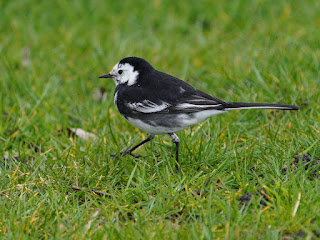A Chiffchaff flitted around in a tree beside the Serpentine.
One of the Long-Tailed Tits nesting near the Italian Garden paused on a hawthorn twig. So far this year I've found four Long-Tailed Tits' nests in the park, and no doubt there are plenty more.
A Robin looked out from a bramble patch beside the Long Water.
There were a lot of Pied Wagtails to be seen: two beside the Round Pond, one of which found a tiny larva ...
... and six around the Serpentine, including this one on the recently laid turf at the southeast corner.
A young male Blackbird came out of the railings of the Dell to look for worms in the soggy ground. Many of the young males we see in winter are migrants, but a resident pair of Blackbirds bred here last year and this is probably their son.
The Grey Herons on the island are back and carrying on their slow, hesitant nesting. This one was starting a nest from scratch.
Their behaviour is quite different from that of the herons in Battersea Park, which nest decisively, all at the same time, in midwinter.
At the east end of the Serpentine a pair of Coots mated ...
... then went to collect twigs from a pile blown into the lake by the recent high winds.
A Moorhen carefully climbed down a steeply sloping branch on the collapsed willow next to the bridge.
Moorhens are omnivorous, and are as happy to eat fresh spring grass as they are to swallow frogs.
The Black Swan performed its neck-bending display to a passing male Mute Swan, which didn't understand the meaning and ignored it. A Carrion Crow in the background watched with interest. The tennis ball was probably dropped here by a young Herring Gull playing with it.
Four Gadwall drakes on the Long Water chased a single female. They have much quieter voices than Mallards.
The Red-Crested Pochard and his Mallard mate ate small water creatures, perhaps insect larvae on the surface of the Italian Garden fountain pool, and grazed on algae. The pochard is a diving duck, which gives it an advantage with the algae.
A fox beside the Long Water stared curiously at the camera and backed off, but didn't flee. Urban foxes are used to the strange habits of people. It's a young fox in beautiful condition, probably one of last year's cubs from one of the four pairs of foxes beside the Long Water.










I don't understand the Black Swan either. Looks like aggression?
ReplyDeleteNice fox. (good diet, likely))
We need an Australian swan translator. Can't think of anyone at the moment.
DeleteOh to be bi-lingual. In Swan.
ReplyDeleteI think the Mute Swans would welcome a translator too so they'd know how to react. But it's weird that they can't detect aggression when it is coached in a different 'language'.
ReplyDeleteStill, poor Black Swan. Stranger in a strange land.
It can be very difficult to distinguish aggression from courtship behaviour, as I have noticed and remarked on in Black-Headed Gulls. I'm still unsure which of these the Black Swan is displaying.
Delete